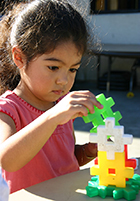Needs-based funding essential for most disadvantaged localities
The Bankwest Curtin Economics Centre's (BCEC) latest report, Educate Australia Fair?: Education Inequality in Australia, examines the extent of educational disadvantage across and within Australia’s states and territories and among vulnerable groups.
“Compared to the most advantaged localities in Australia, children in those 50 areas at greatest educational disadvantage are, on average, half as likely to be enrolled in pre-school at age four, half as likely to attend pre-school for 15 hours or more, and seven times as likely to be vulnerable on two or more developmental domains in their first year of schooling,” said BCEC Director and report author Professor Alan Duncan.
“Our index shows the most disadvantaged areas are located in very remote regions of Australia, spanning the Northern Territory, South Australia and Western Australia. But pockets of disadvantage are also evident on the fringes of our state capital cities.
“Our findings also show that the most disadvantaged students are averaging half the NAPLAN scores in reading, writing and numeracy of those in the least disadvantaged areas.”
The report also found that government funding was well-targeted relative to need, with those in the most disadvantaged areas receiving greater amounts of funding.
“Schools in areas of greatest educational disadvantage receive income of $24,100 per student, some 50 per cent higher than the average of $16,400 for the top 50 areas,” Duncan said. “This demonstrates the need for education policies to go beyond funding reform, and address the complex barriers that exist in delivering education to our most vulnerable children.”
“This demonstrates the need for education policies to go beyond funding reform, and address the complex barriers that exist in delivering education to our most vulnerable children.”
Report co-author and BCEC Principal Research Fellow Assoc Prof Rebecca Cassells believes participation in pre-school education played an important role in outcomes later in life.
“More children are attending pre-school than ever before, however, one in four enrolled children are not accessing at least 15 hours of pre-school each week in their year before starting school,” Cassells said.
“This finding is made more concerning when we see that one in three children living in the lowest SES areas are likely to be developmentally vulnerable in their first year of school, and this likelihood increases by threefold if the child is living in a very remote area.
“At the other end of schooling, we’re seeing that nearly half of young people (49.4 per cent) in the most disadvantaged areas are not studying until they are 17 years old, compared with just 2.5 per cent in the least disadvantaged areas.
“The gap in student attendance rates between Indigenous and non-Indigenous students remains constant throughout primary school, averaging around eight percentage points, but deteriorates rapidly once high school commences, reaching 15 percentage points by Year 10."
Boys were found twice as likely as girls to be developmentally vulnerable.
Report co-author and BCEC Principal Research Fellow Assoc Prof Michael Dockery said the research found a clear link between the level of parent and child education attainment.
“Almost two-thirds of Australians whose parents achieved a university qualification have also gone on to achieve a tertiary level qualification. This compares with those whose parents achieved year 10 or below, where only 21 per cent were able to gain a tertiary qualification,” Dockery said.
“In regards to equity groups, we found the greatest expansion in university enrolments has been by students with a disability and Indigenous Australians, at 171.2 per cent and 92.3 per cent growth respectively between 2001 and 2015."
The key purpose behind the index is to uncover the extent of inequality in educational opportunities by locality and to support the development of targeted and effective policy initiatives that improve school experiences and educational achievements. [SOURCE]